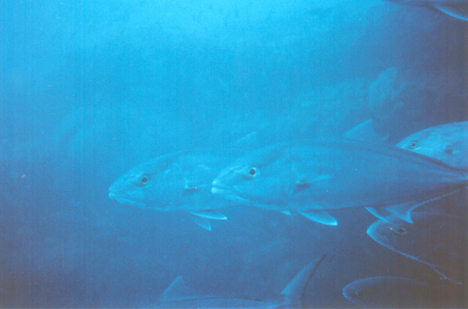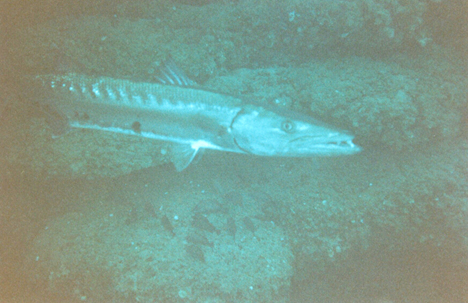The Blue Hole is not the place to use a conventional
anchor, a grapnel hook (which looks like a huge treble hook),
coupled to about fifteen feet of chain, and several hundred
feet of anchor line, is the best tool for the job. When
we slipped over the side, our boat was securely connected
to the hole.
We positioned extra tanks to allow for decompression schedules
as we descended. Looking down into the dark blue hole reminded
me of the "drop off" we had in Cuba.
Randy and I didn't wear swim fins. We were planning on
sinking, not swimming and we had concerns that fins might
stir up silt and obstruct our visibility. We wore neoprene
diver's booties instead.

As we dropped below the Blue Hole's rim, we encountered
a school of jacks, many of which would have weighed thirty
to forty pounds. In looking at the picture, you can see
that there was a fair amount of ambient light. Within just
a few more feet, that began to change rather dramatically.

As we descended, it was is if someone turned down the dimmer
switch - and quickly. When I shot the picture of this five-foot
barracuda, you can see the flash reflected off the silver
at the base of his pectoral fin. Looking at the lower right
corner of the picture, you can begin to get an idea how
dark it was just below us. Dark, and devoid of life - the
barracuda was the last living thing we saw.
As we passed the 100' mark, the air in our buoyancy compensators
began to compress and the more it compressed, the faster
our descent, and the darker the water around us became.
The thing we hadn't imagined can best be demonstrated by
standing a roll of paper towels on a counter top in a brightly
lit kitchen. Look down that tube and you cannot see the
countertop -- you can only see a couple of inches (assuming
the light isn't shining straight into the tube). Diffuse
light does not pass down a tube - especially in water.
It got darker, faster, than we would ever have imagined
- in no time at all, it was like sinking in ink.
Naturally, we brought diving lights, but as any diver knows,
they project a narrowly focused beam. Those lights do not
light up an area very well so, other than what we pointed
them at, we had no idea what was around us.
If you had our descent on film, it would look like a couple
of drunk Jedi Knights falling through space battling away
with light sabers.
It was disorienting, and it was difficult to try and keep
an eye on our surroundings, while watching our depth gauges,
and keeping an eye out for Lord knows what, as we plummeted
toward whatever awaited us on the bottom. One thing I did
notice, the water was not salty at all.
Aside from taste, what does salt water have that freshwater
does not? The answer is, "Buoyancy!" We were descending
through fresh water, and the decreased salinity made us
sink faster.
It also explained the absence of life - the saltwater fish
that could get there cannot live there and the freshwater
fish that could live there cannot get there.
Bearing in mind that the known enemy was time - it was
critically important that we get down and back up as rapidly
as possible and there are severe limits on how fast you
can ascend. For us, dropping fast was a good thing since
we wanted to get to the bottom quickly.
That makes perfect sense, and it's all well and fine while
you're hurtling thru black space until, all of a sudden,
you get this mental image of razor tipped stalagmites sticking
up from the bottom below you. As we past the 200 foot mark,
instantly, and fortunately, with no warning whatsoever,
we discovered that nothing could have been further from
the truth.
"Splat" we went into the underwater equivalent
of quicksand, superfine sand with a texture very similar
to cosmetic liquid make-up.
The Blue Hole is a freshwater spring where water has percolated
up through the sand since "once upon a time,"
or perhaps even the beginning of time. That forever percolating
effect has worn the sand down to a liquid paste - much preferable,
in my view, to razor sharp pointy things!
Randy and I noted the depth, 212 feet, and confirmed that
we were each in possession of our senses - nitrogen narcosis
being a very real concern at that sort of depth. We began
our ascent immediately, but slowly, taking much longer to
get to the rim of the hole than we took getting down.
Fortunately, we found our decompression tanks right where
we left them; but I must tell you that nothing could be
more boring than decompression stops. If you ever choose
to try such a thing, it's about like watching paint dry,
so be sure and bring along a paper back book.
I'm completely serious. Paper back books don't survive
long underwater, but tucked inside your wetsuit, they will
certainly survive long enough. You simply tear away the
pages as you read them - the pages will completely disintegrate
in a few days.
* * * * *
We made that dive thirteen years ago, and I doubt if my
seventeen year-old son Jeremy can remember standing by on
that boat with his Mom. I suppose that's why I write these
things.

For wonderful things remembered
|





